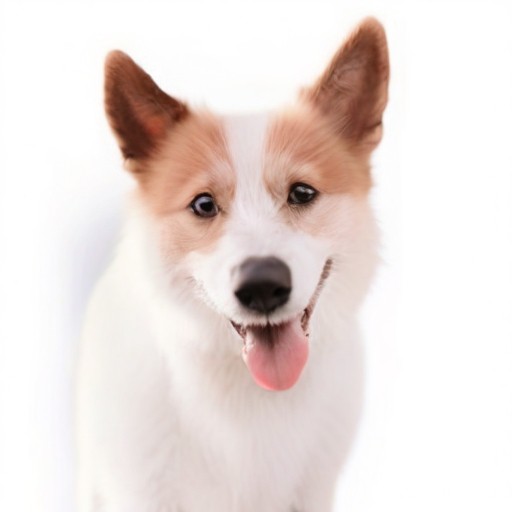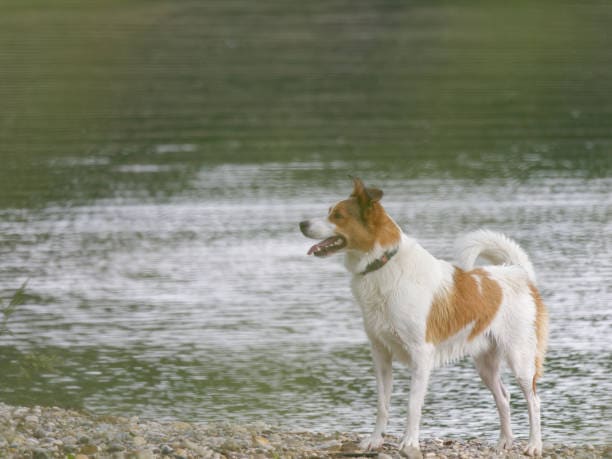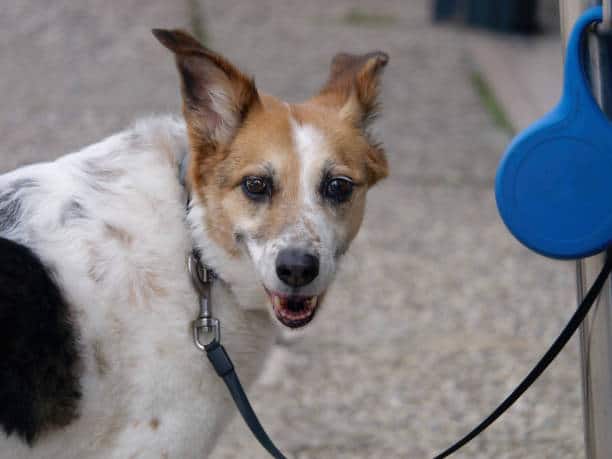The Norrbottenspets, known for its compact size and lively disposition, captures the hearts of those who appreciate small yet energetic working dogs. This breed, often referred to as the “Norrbotten Spitz,” embodies a rich history and a joyful spirit.

| Category (Explanation) | Breed Information |
|---|---|
| Year of Breed Conception | 17th century |
| Country of Origin | Sweden |
| Weight (lbs & kg) (Male) | 20-26 lbs (9-12 kg) |
| Weight (lbs & kg) (Female) | 18-24 lbs (8-11 kg) |
| Coat Type | Double, short |
| Color Variations | White with red or yellow markings |
| Shedding Level (Low, Moderate, High) | Low |
| Height (cm & in) | 16-20 inches (41-51 cm) |
| Breed Size | Small to Medium |
| Trainability (Low, Moderate, High) | High |
| Mental Needs (Low, Moderate, High) | Moderate |
| Intelligence Level (Low, Moderate, High) | High |
| Energy Level (Low, Moderate, High) | Moderate |
| Agility (Low, Moderate, High) | High |
| Loyalty (Low, Moderate, High) | High |
| Playfulness (Low, Moderate, High) | Moderate |
| Exercise Needs | Regular exercise, mental stimulation |
| Guarding Proficiency (Low, Moderate, High) | Moderate |
| Sociability with Children (Low, Moderate, High) | High |
| Barking Level (Low, Moderate, High) | Moderate |
| Digging Tendency (Low, Moderate, High) | Low |
| Destructive Behavior (Low, Moderate, High) | Low |
| Drooling Level (Low, Moderate, High) | Low |
| Obedience Level (Low, Moderate, High) | High |
| Apartment Friendly (Yes/No) | Yes, with proper exercise and mental stimulation |
| Inherent Prey Drive | Moderate |
| Physical Risk to Others (Low, Moderate, High) | Low |
| Travel Fatality Risk (Low, Moderate, High) | Low |
| Allergen Potential | Low |
| Health Concerns (List of Common Health Concerns) | Hip dysplasia, patellar luxation |
| Average Life Expectancy (Life Expectancy in Years) | 12-15 years |
Woof Mastery is reader supported and our articles may contain affiliate links.
Instead of running third party ads that we have no control of we only use links from high-quality companies we are directly partnered with. Making use of these links come at no cost to you our reader, and in many cases have the extra benefit of discounted rates or sign up bonuses.
If you’re interested you can read more about our affiliate policy here.
We appreciate your support and always insure that the products and services we recommend are high-quality, helpful and relevant to the subject at hand!
The Norrbottenspets’ history is closely tied to the northern regions of Sweden and Finland, where they were used for hunting small game, such as squirrels and birds. Their small size, alertness, and agility made them ideal for these tasks.
Their history is marked by their compact size and their role as cheerful companions for families in the North.

What makes the Norrbottenspets special is their compact size and lively disposition. These dogs are known for their versatility, excelling as both hunters and affectionate family members. Their history of aiding in hunting and their role as spirited companions make the Norrbottenspets truly extraordinary.
Norrbottenspets, originating in Sweden, were traditionally used as versatile hunting dogs, excelling in hunting small game in the northern forests.
Their traditional role included tracking and flushing out game, showcasing their agility and hunting skills.
Norrbottenspets are known for their intelligence, agility, and friendly nature. They are often affectionate and loyal to their families, displaying a spirited and energetic personality. These dogs require mental stimulation and regular exercise to stay happy.
Norrbottenspets are known for their intelligence, alertness, and friendly nature. They are often affectionate and loyal to their families, displaying a strong work ethic and an energetic disposition. These dogs require mental stimulation and regular exercise to stay happy.
Norrbottenspets have a small to medium-sized build with a lively and alert appearance. They have erect, triangular ears, bright, almond-shaped eyes, and a double coat designed for insulation. Coat colors often include shades of white with red markings or red with white markings. Their tails are plumed and carried over their backs.
Norrbottenspets have a dense double coat in colors like white, black, and tan. Their colors enhance their hardworking and tenacious character. Norrbottenspets have a dense double coat that typically comes in colors like white, black, and tan. These colors add to their overall hardworking and tenacious character. Norrbottenspets are beloved for their resilient and determined nature, and their coat’s color variations reflect their distinctive and dependable character.
Norrbottenspets have a dense double coat in patterns like white, black, and tan. Their patterns enhance their hardworking and tenacious character. Norrbottenspets have a dense double coat that typically comes in patterns like white, black, and tan. These patterns add to their overall hardworking and tenacious character. Norrbottenspets are beloved for their resilient and determined nature, and their coat pattern’s variations reflect their distinctive and dependable character.
Norrbottenspets have a low shedding level. They are known for their minimal shedding, making them an excellent choice for those who are concerned about allergies or excessive grooming. While no dog is entirely hypoallergenic, Norrbottenspets produce fewer allergenic proteins in their saliva and skin oils compared to other breeds. Regular grooming and brushing can help keep their coat in excellent condition and reduce shedding to a minimum.
Norrbottenspets have a short, dense coat that requires minimal grooming to keep it healthy. Here are some grooming habits for this breed:
Brushing: Occasional brushing, about once a week, is sufficient to keep their coat in good condition. A soft-bristle brush or rubber curry brush can be used. Bathing: Norrbottenspets do not require frequent baths, as their coat is naturally dirt-repellent. Bathing should only be done when necessary, using a dog-specific shampoo. Ears: Check and clean their ears regularly to prevent wax buildup or infections. Use a damp cotton ball or a veterinarian-recommended ear cleaning solution. Nails: Keep their nails trimmed to a comfortable length to prevent discomfort and maintain proper gait. Teeth: Dental hygiene is important. Brush their teeth regularly to prevent dental issues and bad breath. Dental chews or toys can also help.
Norrbottenspets have a moderate activity level and enjoy outdoor activities. Here are key points to consider about their activity level:
Exercise Needs: They require daily exercise to stay happy and healthy. Activities can include daily walks, playtime, and interactive games. Energy Level: They have a moderate energy level and enjoy both active play and relaxation. Mental Stimulation: Provide mental stimulation through interactive toys and obedience training. Weather Consideration: Norrbottenspets can tolerate cold weather well but should be protected from extreme heat. Be cautious of exercise during hot weather.
Norrbottenspets are intelligent and alert dogs known for their problem-solving abilities. Here are some key points about their intelligence:
Trainability: They are intelligent and trainable, responding well to positive reinforcement methods. Problem-Solving: Norrbottenspets excel in problem-solving and enjoy engaging activities. Independence: They may exhibit some independence but are generally eager to work with their owners. Work Ethics: They have a strong work ethic and were historically bred for hunting. Social Intelligence: Norrbottenspets tend to be socially intelligent and can form strong bonds with their families.
Training should focus on their intelligence and their need for mental stimulation.
Meeting the mental needs of Norrbottenspets is important for their well-being. Here are some considerations:
Social Interaction: They need regular social interaction and enjoy being part of the family. Loneliness can lead to boredom. Training and Obedience: Obedience training not only provides mental stimulation but also reinforces their bond with their owners. Consistency and positive reinforcement are key. Mental Stimulation: Engage them in activities that challenge their minds, such as puzzle toys or obedience training. Routine and Structure: Dogs thrive on routine and structure. Establishing a predictable daily routine can help them feel secure and reduce anxiety. Affection and Attention: Norrbottenspets thrive on human companionship and affection. Show them love and spend quality time together. Socialization: Early socialization is important to ensure they are comfortable around different people and animals. Safe Environment: Create a safe and comfortable environment at home where they can relax and feel secure. Consistency: Consistency in training and daily routines helps them feel more secure and confident in their environment.
Enter The Woof Mastery

Considering a Norrbottenspets? Here’s what you should know:
Size: They are a small breed with unique traits.
Grooming: Their coat requires regular care to prevent matting.
Training: They are intelligent but may require firm, consistent training.
Socialization: Early socialization is vital for their behavior around other pets and people.
Norrbottenspets are generally low-risk dogs due to their small size and friendly disposition:
Size: Their smaller size reduces the potential for physical harm.
Grooming: Regular grooming is necessary to maintain their coat’s health and appearance.
Training: Proper training minimizes the risk of unwanted behavior, although it’s rarely an issue with Norrbottenspets.
Norrbottenspets dogs are generally good with children when properly socialized and trained:
Temperament: They are friendly and enjoy the company of kids.
Size: They are small to medium-sized dogs, suitable for families.
Socialization: Early socialization is important to ensure they get along with children and other pets.
Training: Training is essential to ensure they behave appropriately around kids.
Norrbottenspets dogs can be good swimmers, but their ability may vary:
Size: Their small to medium size affects their buoyancy, so supervision is necessary.
Comfort Level: Some may enjoy swimming, while others may be more cautious. Gradual introductions can help build their confidence.
Life Vest: Consider using a canine life vest, especially in open water or deep pools.
Safety Precautions: Be aware of potential hazards and never leave your dog unattended near water.
Norrbottenspets puppies are intelligent and active. Here are some tips for training them:
Training your Norrbottenspets puppy is a great way to create a strong bond and ensure they grow into well-behaved adults.
Norrbottenspets, a Swedish breed, are known for their alert and lively nature. Their vocalizations include:
Norrbottenspets are known for their charming and lively personality and are relatively moderate in terms of vocalization.
Norrbottenspets thrive in homes that cater to their energetic and alert nature, providing a combination of companionship, outdoor activities, regular socialization, and a well-structured routine. Attending to the specific needs of this Swedish hunting breed ensures their overall happiness and well-being.
Challenges:
When it comes to travel fatality risk for Norrbottenspets, a lively and alert Swedish breed, consider the following potential constraints to ensure a safe and enjoyable journey for both you and your spirited companion:
By addressing these potential constraints and taking necessary precautions, you can help ensure the safe travel of your Norrbottenspets, minimizing travel-related risks and creating a positive journey experience for both you and your lively companion.
Norrbottenspets may be prone to specific health concerns. While not all individuals will experience these issues, it’s essential for Norrbottenspets owners to be aware of potential health problems and work with veterinarians to maintain their pets’ well-being. Common health concerns in Norrbottenspets include:
Regular veterinary check-ups, a balanced diet, proper exercise, and responsible breeding practices can help mitigate some of these health concerns. It’s crucial for Norrbottenspets owners to work closely with their veterinarians to monitor their pets’ health and address any issues promptly.
Proper nutrition is crucial for the health and well-being of Norrbottenspets. Here are some nutritional habits and best practices to consider for this breed:
Breed-Specific Laws (BSL): Norrbottenspets may be subject to breed-specific laws (BSL) in certain areas. These laws are often enacted at the local or municipal level and can vary widely from one jurisdiction to another.
Types of Restrictions: The specific restrictions imposed on Norrbottenspets under BSL can include mandatory spaying/neutering, special licensing, liability insurance requirements, muzzling in public, and, in some cases, bans on ownership. The severity of these restrictions depends on local regulations.
Rationale for BSL: BSL is typically implemented based on concerns about public safety and perceived risks associated with specific breeds, often due to incidents involving dog attacks. While Norrbottenspets are not inherently aggressive, they can be affected by BSL due to their physical resemblance to breeds that are sometimes included in these laws.
Controversy: It’s important to note that BSL is a controversial topic. Critics argue that it unfairly targets breeds rather than addressing individual dog behavior and that responsible ownership and training should be emphasized instead of breed-specific restrictions.
Local Regulations: To determine if there are breed-specific laws or restrictions regarding Norrbottenspets in your area, you should check with your local animal control or government authorities. Be aware of and comply with any local regulations to ensure that you are in compliance with the law while owning a Norrbottenspet.
Woof Mastery is reader supported and our articles may contain affiliate links.
Instead of running third party ads that we have no control of we only use links from high-quality companies we are directly partnered with. Making use of these links come at no cost to you our reader, and in many cases have the extra benefit of discounted rates or sign up bonuses.
If you’re interested you can read more about our affiliate policy here.
We appreciate your support and always insure that the products and services we recommend are high-quality, helpful and relevant to the subject at hand!
Myth 1: Norrbottenspets Dogs Are Always Hyperactive
Myth 2: They Are Not Good with Children
Myth 3: Norrbottenspets Dogs Cannot Be Trained
Myth 4: They Cannot Live in Warmer Climates
Myth 5: Norrbottenspets Dogs Are Always Aloof
Myth 6: They Are Not Playful
Myth 7: Norrbottenspets Dogs Are Not Good with Other Pets
Myth 8: They Require Excessive Exercise
Myth 9: Norrbottenspets Dogs Are Always Independent
Myth 10: They Are Not Good for Novice Owners
These myths highlight the importance of understanding individual characteristics of Norrbottenspets dogs and dispelling common misconceptions. Responsible ownership, proper care, and positive training contribute to a positive and enriching relationship with this energetic and affectionate breed.
These enchanting Norrbottenspets mascots, including Northern Navigator, Snowflake Spark, and Arctic Ambassador, embody the breed’s agility and continue to be celebrated symbols in their respective contexts.
The Norrbottenspets holds cultural significance in various contexts:
While there may not be as many famous Norrbottenspets owners as there are for other dog breeds, here are a few notable individuals who have been associated with Norrbottenspets:
Norrbottenspets, like many other dog breeds, have faced several threats and challenges over the years. Some of the significant threats and issues that have affected the breed include:
The Norrbottenspets is believed to have been developed from a combination of various breeds, with the primary ancestors being the Swedish Elkhound, Finnish Spitz, and Norwegian Lundehund. The breed’s development occurred over several centuries, with influences from different regional strains and breed types. The specific breeds and strains that contributed to the Norrbottenspets’s development include:
Norrbottenspets epitomize the essence of cherished family companions. With their unwavering loyalty and affection, they seamlessly integrate into our lives, providing not only security but also heartfelt devotion. As excellent watchdogs, their alert instincts further solidify their role as guardians of our homes.
Their friendly and agile nature makes them perfect playmates for families with children, effortlessly adapting to various living conditions while requiring moderate exercise. Their fox-like face and energetic demeanor add a lively presence to every household. Their versatility is a testament to their adaptability, transitioning effortlessly from beloved family pets to diligent working dogs.
Above all, these dogs offer an unparalleled gift—profound and unwavering love. They become more than pets; they become treasured family members, enriching our lives with their unwavering companionship and forging an unbreakable bond that lasts a lifetime.
Now, we invite you to discover the incredible love and devotion that this remarkable breed has to share. Bring a Norrbottenspets into your life and experience the enduring joy and companionship they bring.